- Removal and installation of the steering sensor
- Removal and installation of the connector of the steering sensor
- Replacement
| Last Modified: 01-30-2024 | 6.11:8.1.0 | Doc ID: RM100000001FRE0 |
| Model Year Start: 2019 | Model: RAV4 | Prod Date Range: [11/2018 - 10/2022] |
| Title: PARK ASSIST / MONITORING: PANORAMIC VIEW MONITOR SYSTEM (for Gasoline Model): CALIBRATION; 2019 - 2022 MY RAV4 [11/2018 - 10/2022] | ||
CALIBRATION
ADJUST PANORAMIC VIEW MONITOR SYSTEM
NOTICE:
- If any of the work in the following table has been performed, perform registration of the panoramic view monitor system.
- Work performed during servicing may require the registration and initialization of the panoramic view monitor system and other systems.
- Conduct the pre-work checks (Procedure 1) before performing screen adjustment.
|
Part Name |
Operation |
Adjustment Item |
Proceed to |
|---|---|---|---|
| *: When "!" is displayed on the panoramic view monitor screen, perform steering angle neutral point. | |||
|
Steering sensor |
|
Steering angle neutral point (Initialize panoramic view monitor system)* |
|
|
Adjust steering angle |
Procedure 9 |
||
|
Parking assist ECU |
Replacement |
Parking assist ECU initialization |
Procedure 2 |
|
Procedure 7 |
|||
|
Procedure 8 |
|||
|
Adjust steering angle |
Procedure 9 |
||
|
Suspension, tires, etc. |
The vehicle height changes because of suspension or tire replacement |
Parking assist ECU initialization |
Procedure 2 |
|
Procedure 7 |
|||
|
Procedure 8 |
|||
|
Adjust steering angle |
Procedure 9 |
||
|
|
Front television camera view adjustment |
Procedure 2 |
|
Procedure 3 |
|||
|
Procedure 8 |
|||
|
Television camera assembly |
|
Television camera view adjustment |
Procedure 2 |
|
Procedure 4 |
|||
|
Procedure 8 |
|||
|
|
Side television camera view adjustment |
Procedure 2 |
|
Procedure 5 |
|||
|
Procedure 8 |
|||
|
|
Side television camera view adjustment |
Procedure 2 |
|
Procedure 6 |
|||
|
Procedure 8 |
|||
|
Replacement or removal and installation of 2 or more parts |
Television camera view adjustment |
Procedure 2 |
|
Procedure 7 |
|||
|
Procedure 8 |
|||
PROCEDURE 1: PRE-WORK CHECKS
(a) Preliminary checks
NOTICE:
- Provide shadow to prevent backlight from hitting the camera.
- Use string that does not stretch.
- Apply pieces of adhesive tape to serve as check markers. When placing the markers, make them 100 mm (3.94 in.) wide.
(1) Perform the work in a wide, level location. (Approximately 2000 mm [6.56 ft.] to the front, rear, left and right around the vehicle)
(2) Park the vehicle on a flat surface with the steering wheel centered.
NOTICE:
Before stopping the vehicle, move the vehicle backward and forward to ensure that both the steering wheel and the tires point straight ahead.
(3) Adjust the tire pressure to the specified value(s).
(4) Remove all luggage from the vehicle and place the markers before starting work.
(b) Marker locations
(1) Secure the strings and markers to the location required to make the checks as shown in the illustration.
-
When adjusting front camera only
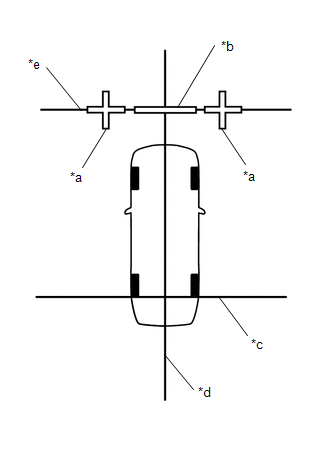
*a
Cross Check Marker
*b
Check Marker
*c
String 1
*d
String 2
*e
String 3
-
When adjusting rear camera only
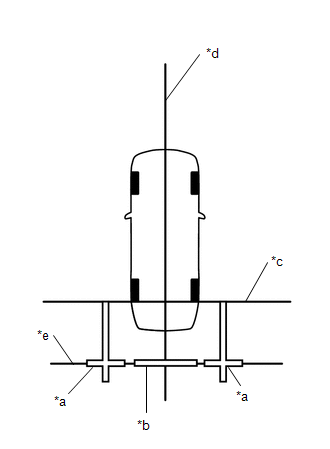
*a
Cross Check Marker
*b
Check Marker
*c
String 1
*d
String 2
*e
String 4
-
When adjusting side camera LH only

*a
Cross Check Marker
*b
Check Marker
*c
String 1
*d
String 2
*e
String 3
*f
String 4
*g
String 5
-
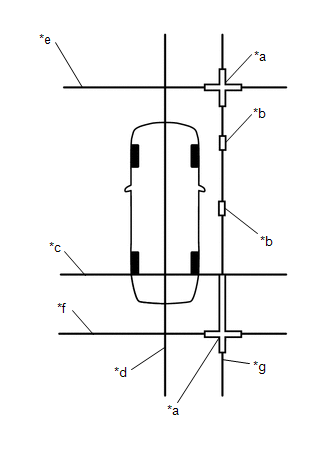
When adjusting side camera RH only*a
Cross Check Marker
*b
Check Marker
*c
String 1
*d
String 2
*e
String 3
*f
String 4
*g
String 6
-
When adjusting all cameras
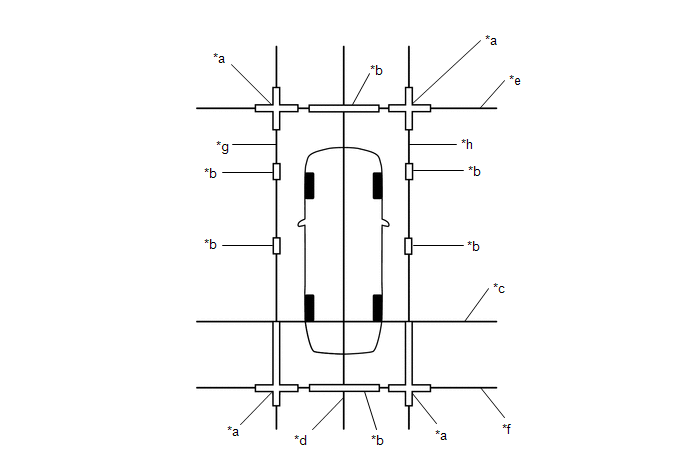
*a
Cross Check Marker
*b
Check Marker
*c
String 1
*d
String 2
*e
String 3
*f
String 4
*g
String 5
*h
String 6
(c) Marker positions
(1) Set the target bars in the positions shown in the illustration.
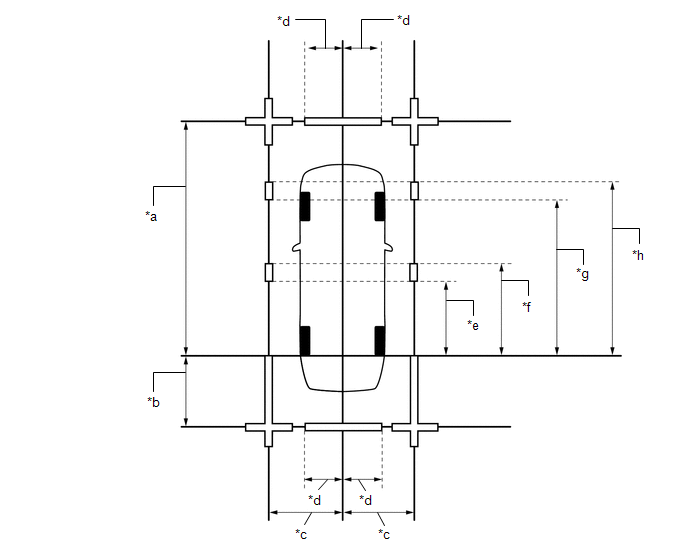
|
*a |
except Off Road Package: 4800 mm (15.74 ft.) for Off Road Package: 4700 mm (15.42 ft.) |
*b |
1300 mm (4.26 ft.) |
|
*c |
1500 mm (4.92 ft.) |
*d |
693 mm (2.27 ft.) |
|
*e |
1400 mm (4.59 ft.) |
*f |
1600 mm (5.25 ft.) |
|
*g |
3000 mm (9.84 ft.) |
*h |
3200 mm (10.5 ft.) |
PROCEDURE 2: SET DATUM POINTS
(a) Extend the datum line [string (1)].
(1) Hang a weight with a pointed tip at the position shown in the illustration and accurately mark the center position on the road surface. (Mark A)
NOTICE:
Observe the string to check that the weight hangs straight down.
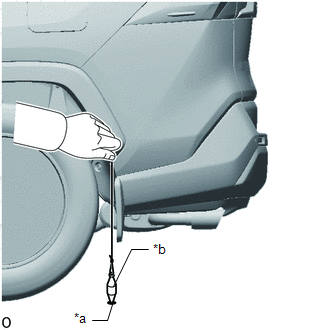
|
*a |
Mark A |
|
*b |
Weight |
(2) Repeat the procedure to mark the right side. (Mark B)
(3) Secure string (1) to pass through marks A and B at the left and right sides.
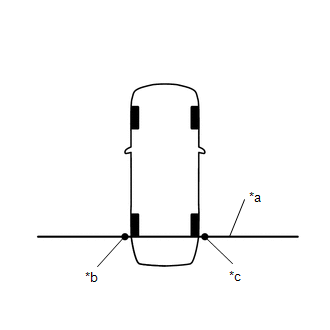
|
*a |
String 1 |
|
*b |
Mark A |
|
*c |
Mark B |
NOTICE:
When securing the string, check that there is no slack and the string is not twisted.
(b) Extend the vehicle center line [string (2)].
(1) Hang a weight with a pointed tip so that it passes through the center of the front television camera assembly and accurately mark the center position on the road surface. (Mark C)
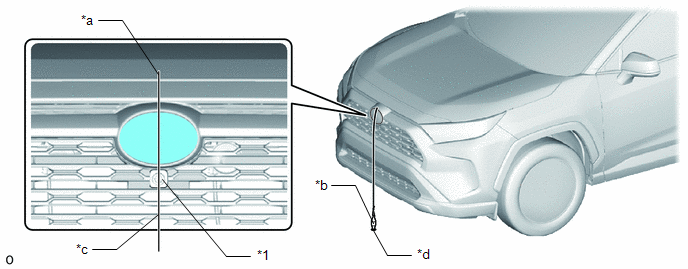
|
*1 |
Front Television Camera Assembly |
- |
- |
|
*a |
Center Point |
*b |
Weight |
|
*c |
String |
*d |
Mark C |
(2) Hang a weight with a pointed tip so that it passes through the center of the rear emblem and accurately mark the center position on the road surface. (Mark D)
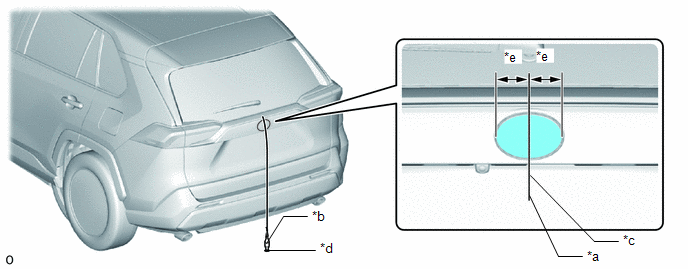
|
*a |
Center |
*b |
Weight |
|
*c |
String |
*d |
Mark D |
|
*e |
Equal on both sides |
- |
- |
(3) Secure string (2) to pass through marks C and D at the front and rear of the vehicle.
NOTICE:
When securing the string, check that there is no slack and the string is not twisted.
HINT:
Set the point where strings 1 and 2 intersect as the datum point.
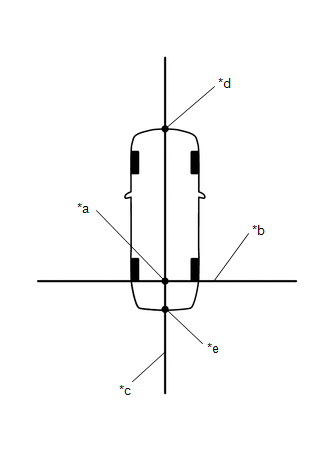
|
*a |
Datum Point |
|
*b |
String 1 |
|
*c |
String 2 |
|
*d |
Mark C |
|
*e |
Mark D |
PROCEDURE 3: SET MARKERS (FRONT ADJUSTMENT)
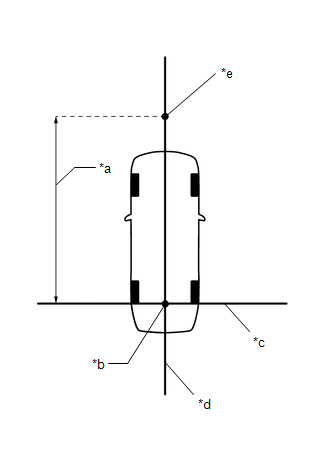
|
*a |
except Off Road Package: 4800 mm (15.74 ft.) for Off Road Package: 4700 mm (15.42 ft.) |
|
*b |
Datum Point |
|
*c |
String 1 |
|
*d |
String 2 |
|
*e |
Mark E |
(a) In front of the vehicle, extend string (3) perpendicular to the vehicle center line [string (2)], and place a marker.
(1) except Off Road Package:
- Mark a position on string (2) in front of the vehicle, 4800 mm (15.74 ft.) from the datum point. (Mark E)
(2) for Off Road Package:
- Mark a position on string (2) in front of the vehicle, 4700 mm (15.42 ft.) from the datum point. (Mark E)
(3) Fix the ends of 2 strings (800 mm [2.62 ft.] long) at 2 positions 400 mm (1.31 ft.) from mark E as shown in the illustration.
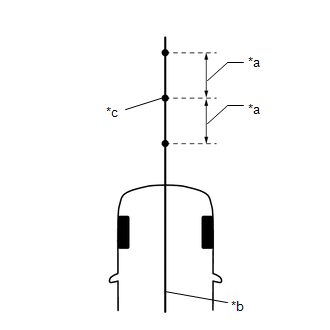
|
*a |
400 mm (1.31 ft.) |
|
*b |
String 2 |
|
*c |
Mark E |
(4) Move the free ends of the 2 strings and mark the point where the ends meet. (Marks F and G)
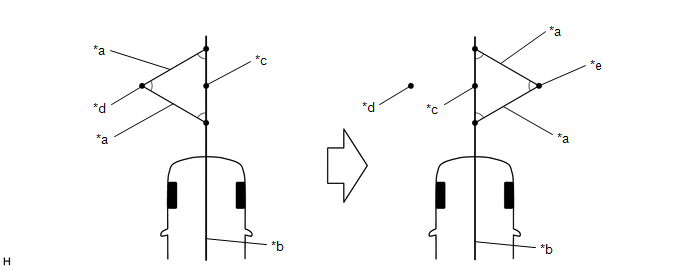
|
*a |
800 mm (2.62 ft.) String |
*b |
String 2 |
|
*c |
Mark E |
*d |
Mark F |
|
*e |
Mark G |
- |
- |
(5) Secure string (3) to pass through marks F and G as shown in the illustration.
NOTICE:
When securing the string, check that there is no slack and the string is not twisted.
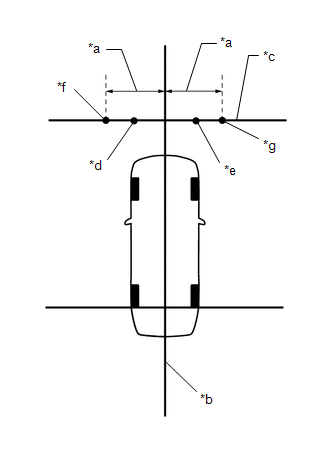
|
*a |
1500 mm (4.92 ft.) |
|
*b |
String 2 |
|
*c |
String 3 |
|
*d |
Mark F |
|
*e |
Mark G |
|
*f |
Mark H |
|
*g |
Mark I |
(6) Make a mark on string (3), 1500 mm (4.92 ft.) to the left and right of the vehicle center line (string (2)). (Marks H and I)
(7) Place and secure the cross target bars, centered on marks H and I as shown in the illustration.
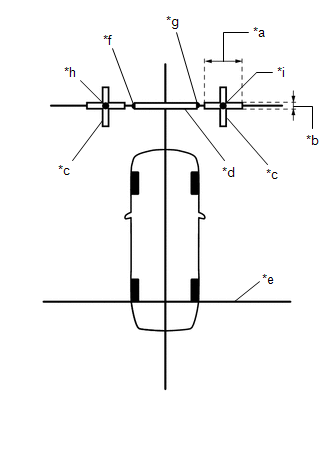
|
*a |
800 mm (2.62 ft.) |
|
*b |
100 mm (0.33 ft.) |
|
*c |
Cross Check Marker |
|
*d |
Check Marker |
|
*e |
String 1 |
|
*f |
Mark F |
|
*g |
Mark G |
|
*h |
Mark H |
|
*i |
Mark I |
NOTICE:
- Place the cross check markers perpendicular to the string.
- Make each arm of the cross check markers 800 mm (2.62 ft.) long and 100 mm (0.33 ft.) wide.
(8) Place the target bar between marks F and G.
(9) Perform the screen adjustment procedure (procedure 8).
PROCEDURE 4: SET MARKERS (REAR ADJUSTMENT)
(a) To the rear of the vehicle, extend string (4) perpendicular to the vehicle center line [string (2)], and place a check marker.
(1) Mark a position on string (2) to the rear of the vehicle, 1300 mm (4.26 ft.) from the datum point. (Mark J)
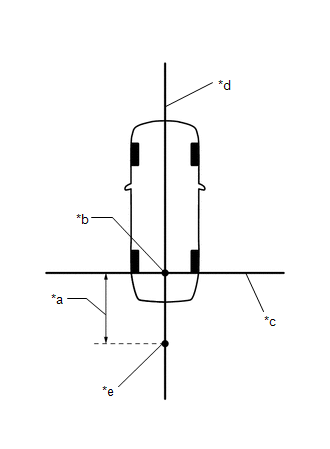
|
*a |
1300 mm (4.26 ft.) |
|
*b |
Datum Point |
|
*c |
String 1 |
|
*d |
String 2 |
|
*e |
Mark J |
(2) Fix the ends of two 800 mm (2.62 ft.) strings at two positions 400 mm (1.31 ft.) from mark J as shown in the illustration.
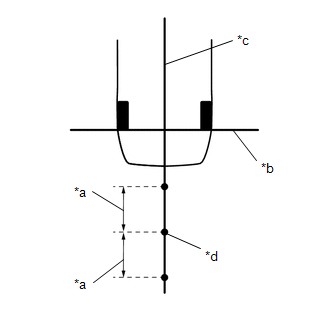
|
*a |
400 mm (1.31 ft.) |
|
*b |
String 1 |
|
*c |
String 2 |
|
*d |
Mark J |
(3) Move the free ends of the 2 strings and mark the point where the ends meet. (Marks K and L)
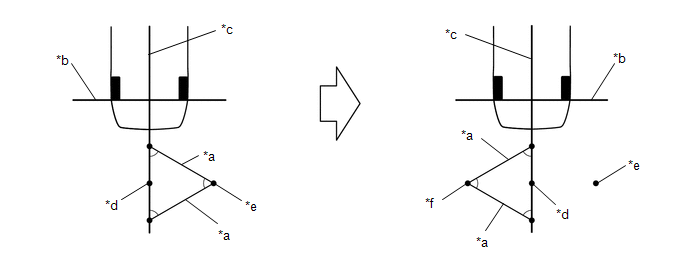
|
*a |
800 mm (2.62 ft.) String |
*b |
String 1 |
|
*c |
String 2 |
*d |
Mark J |
|
*e |
Mark K |
*f |
Mark L |
(4) Secure string (4) to pass through marks K and L as shown in the illustration.
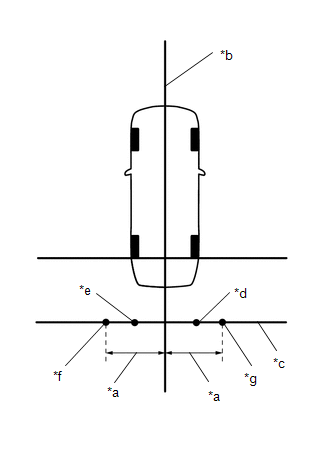
|
*a |
1500 mm (4.92 ft.) |
|
*b |
String 2 |
|
*c |
String 4 |
|
*d |
Mark K |
|
*e |
Mark L |
|
*f |
Mark M |
|
*g |
Mark N |
NOTICE:
When securing the string, check that there is no slack and the string is not twisted.
(5) Make a mark on string (4), 1500 mm (4.92 ft.) to the left and right of the vehicle center line [string (2)].
(6) Place and secure the cross target bars, centered on marks M and N as shown in the illustration.
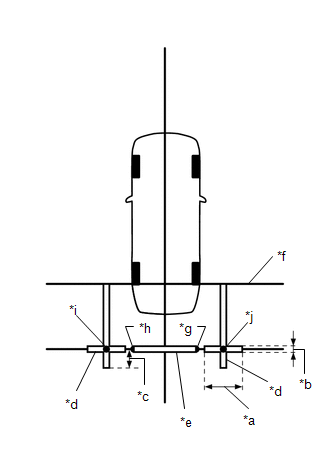
|
*a |
800 mm (2.62 ft.) |
|
*b |
100 mm (0.33 ft.) |
|
*c |
400 mm (1.31 ft.) |
|
*d |
Cross Check Marker |
|
*e |
Check Marker |
|
*f |
String 1 |
|
*g |
Mark K |
|
*h |
Mark L |
|
*i |
Mark M |
|
*j |
Mark N |
NOTICE:
- Place the cross check markers perpendicular to the string.
- Make each arm of the cross check markers 800 mm (2.62 ft.) long and 100 mm (0.33 ft.) wide.
- Extend the rear cross target bars to string (1) as shown in the illustration.
(7) Place the target bar between marks K and L.
(8) Perform the screen adjustment procedure (procedure 8).
PROCEDURE 5: SET MARKERS (LEFT-SIDE ADJUSTMENT)
(a) At the left side of the vehicle, extend [string (5)] parallel to the vehicle center line [string (2)], and place a marker.
(1) except Off Road Package:
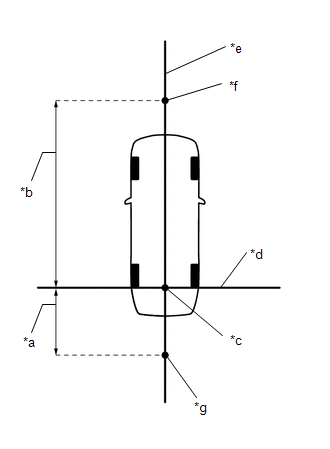
|
*a |
1300 mm (4.26 ft.) |
|
*b |
except Off Road Package: 4800 mm (15.74 ft.) for Off Road Package: 4700 mm (15.42 ft.) |
|
*c |
Datum Point |
|
*d |
String 1 |
|
*e |
String 2 |
|
*f |
Mark E |
|
*g |
Mark J |
- Mark a position on string (2) in front of the vehicle, 4800 mm (15.7 ft.) from the datum point. (Mark E)
(2) for Off Road Package:
- Mark a position on string (2) in front of the vehicle, 4700 mm (15.42 ft.) from the datum point. (Mark E)
(3) Mark a position on string (2) to the rear of the vehicle, 1300 mm (4.26 ft.) from the datum point. (Mark J)
(4) Fix the ends of 2 strings (800 mm [2.62 ft.] long) at 2 positions 400 mm (1.31 ft.) from mark E as shown in the illustration.

|
*a |
400 mm (1.31 ft.) |
|
*b |
String 2 |
|
*c |
Mark E |
(5) Move the free ends of the 2 strings and mark the point where the ends meet. (Marks F and G)

|
*a |
800 mm (2.62 ft.) String |
*b |
String 2 |
|
*c |
Mark E |
*d |
Mark F |
|
*e |
Mark G |
- |
- |
(6) Fix the ends of two 800 mm (2.62 ft.) strings at two positions 400 mm (1.31 ft.) from mark J as shown in the illustration.

|
*a |
400 mm (1.31 ft.) |
|
*b |
String 1 |
|
*c |
String 2 |
|
*d |
Mark J |
(7) Move the free ends of the 2 strings and mark the point where the ends meet. (Marks K and L)

|
*a |
800 mm (2.62 ft.) String |
*b |
String 1 |
|
*c |
String 2 |
*d |
Mark J |
|
*e |
Mark K |
*f |
Mark L |
(8) Secure strings (3) and (4) to pass through marks F and G and marks K and L, respectively as shown in the illustration.
NOTICE:
When securing the string, check that there is no slack and the string is not twisted.
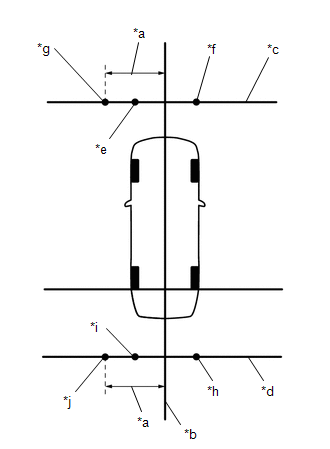
|
*a |
1500 mm (4.92 ft.) |
|
*b |
String 2 |
|
*c |
String 3 |
|
*d |
String 4 |
|
*e |
Mark F |
|
*f |
Mark G |
|
*g |
Mark H |
|
*h |
Mark K |
|
*i |
Mark L |
|
*j |
Mark M |
(9) Mark strings 3 and 4, 1500 mm (4.92 ft.) to the left of the vehicle center line (string 2). (Marks H and M)
(10) Secure string (5) to pass through marks H and M as shown in the illustration.
NOTICE:
When securing the string, check that there is no slack and the string is not twisted.
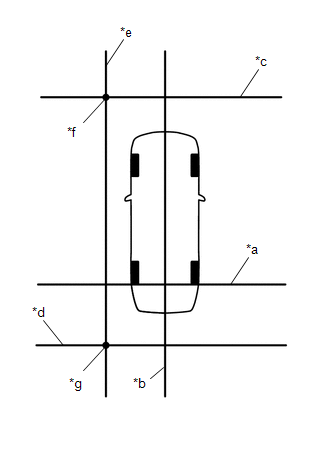
|
*a |
String 1 |
|
*b |
String 2 |
|
*c |
String 3 |
|
*d |
String 4 |
|
*e |
String 5 |
|
*f |
Mark H |
|
*g |
Mark M |
(11) Make marks on string 5 that are 1400 mm (4.59 ft.), 1600 mm (5.25 ft.), 3000 mm (9.84 ft.) and 3200 mm (10.5 ft.) from the datum line (string 1) as shown in the illustration. (Marks O, P, Q and R)
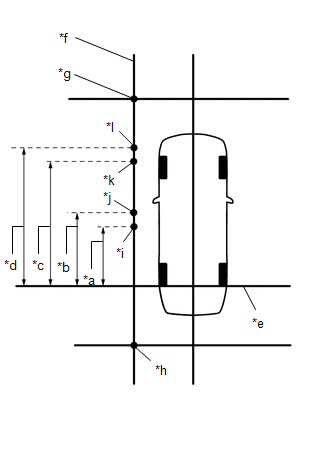
|
*a |
1400 mm (4.59 ft.) |
|
*b |
1600 mm (5.25 ft.) |
|
*c |
3000 mm (9.84 ft.) |
|
*d |
3200 mm (10.5 ft.) |
|
*e |
String 1 |
|
*f |
String 5 |
|
*g |
Mark H |
|
*h |
Mark M |
|
*i |
Mark O |
|
*j |
Mark P |
|
*k |
Mark Q |
|
*l |
Mark R |
(12) Place and secure the cross target bars, centered on marks H and M as shown in the illustration.
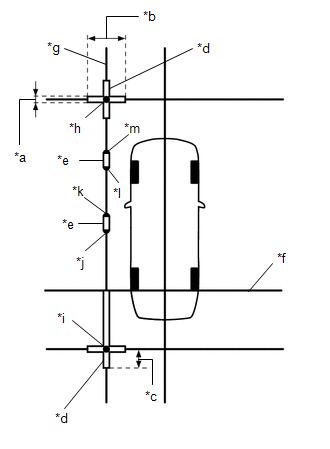
|
*a |
100 mm (0.33 ft.) |
|
*b |
800 mm (2.62 ft.) |
|
*c |
400 mm (1.31 ft.) |
|
*d |
Cross Check Marker |
|
*e |
Check Marker |
|
*f |
String 1 |
|
*g |
String 5 |
|
*h |
Mark H |
|
*i |
Mark M |
|
*j |
Mark O |
|
*k |
Mark P |
|
*l |
Mark Q |
|
*m |
Mark R |
NOTICE:
- Place the cross check markers perpendicular to the string.
- Make each arm of the cross check markers 800 mm (2.62 ft.) long and 100 mm (0.33 ft.) wide.
- Extend the rear cross target bars to string (1) as shown in the illustration.
(13) Place target bar between marks O and P and marks Q and R.
(14) Perform the screen adjustment procedure (procedure 8).
PROCEDURE 6: SET MARKERS (RIGHT-SIDE ADJUSTMENT)
(a) At the right side of the vehicle, extend [string (6)] parallel to the vehicle center line [string (2)], and place a marker.
(1) except Off Road Package:

|
*a |
1300 mm (4.26 ft.) |
|
*b |
except Off Road Package: 4800 mm (15.74 ft.) for Off Road Package: 4700 mm (15.42 ft.) |
|
*c |
Datum Point |
|
*d |
String 1 |
|
*e |
String 2 |
|
*f |
Mark E |
|
*g |
Mark J |
- Mark a position on string (2) in front of the vehicle, 4800 mm (15.74 ft.) from the datum point. (Mark E)
(2) for Off Road Package:
- Mark a position on string (2) in front of the vehicle, 4700 mm (15.42 ft.) from the datum point. (Mark E)
(3) Mark a position on string (2) to the rear of the vehicle, 1300 mm (4.26 ft.) from the datum point. (Mark J)
(4) Fix the ends of 2 strings (800 mm [2.62 ft.] long) at 2 positions 400 mm (1 .31 ft.) from mark E as shown in the illustration.

|
*a |
400 mm (1.31 ft.) |
|
*b |
String 2 |
|
*c |
Mark E |
(5) Move the free ends of the 2 strings and mark the point where the ends meet. (Marks F and G)

|
*a |
800 mm (2.62 ft.) String |
*b |
String 2 |
|
*c |
Mark E |
*d |
Mark F |
|
*e |
Mark G |
- |
- |
(6) Fix the ends of two 800 mm (2.62 ft.) strings at two positions 400 mm (1.31 ft.) from mark J as shown in the illustration.

|
*a |
400 mm (1.31 ft.) |
|
*b |
String 1 |
|
*c |
String 2 |
|
*d |
Mark J |
(7) Move the free ends of the 2 strings and mark the point where the ends meet. (Marks K and L)

|
*a |
800 mm (2.62 ft.) String |
*b |
String 1 |
|
*c |
String 2 |
*d |
Mark J |
|
*e |
Mark K |
*f |
Mark L |
(8) Secure strings (3) and (4) to pass through marks F and G and marks K and L, respectively as shown in the illustration.
NOTICE:
When securing the string, check that there is no slack and the string is not twisted.
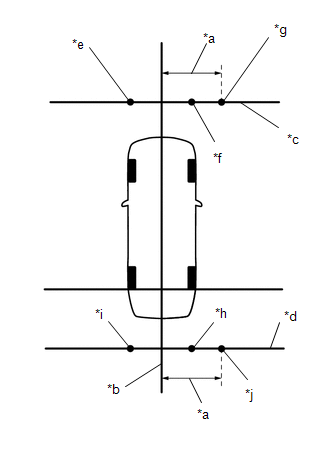
|
*a |
1500 mm (4.92 ft.) |
|
*b |
String 2 |
|
*c |
String 3 |
|
*d |
String 4 |
|
*e |
Mark F |
|
*f |
Mark G |
|
*g |
Mark I |
|
*h |
Mark K |
|
*i |
Mark L |
|
*j |
Mark N |
(9) Mark positions on strings 3 and 4, 1500 mm (4.92 ft.) to the right of the vehicle center line (string 2). (Marks I and N)
(10) Secure string (6) to pass through marks I and N as shown in the illustration.
NOTICE:
When securing the string, check that there is no slack and the string is not twisted.
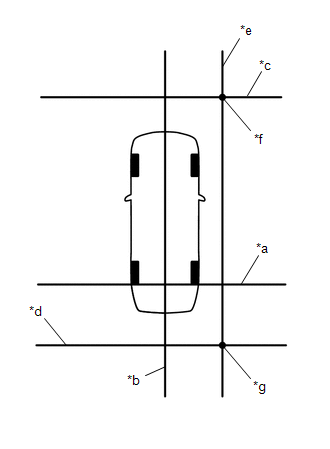
|
*a |
String 1 |
|
*b |
String 2 |
|
*c |
String 3 |
|
*d |
String 4 |
|
*e |
String 6 |
|
*f |
Mark I |
|
*g |
Mark N |
(11) Make marks on string 6 that are 1400 mm (4.59 ft.), 1600 mm (5.25 ft.), 3000 mm (9.84 ft.), and 3200 mm (10.5 ft.) from the datum line (string 1) as shown in the illustration. (Marks S, T, U and V)
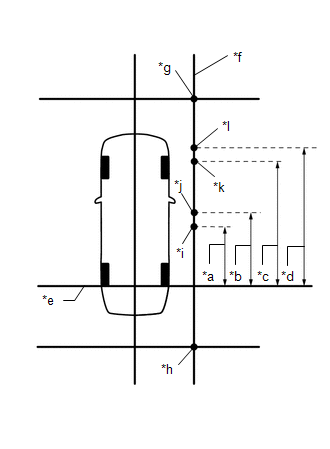
|
*a |
1400 mm (4.59 ft.) |
|
*b |
1600 mm (5.25 ft.) |
|
*c |
3000 mm (9.84 ft.) |
|
*d |
3200 mm (10.5 ft.) |
|
*e |
String 1 |
|
*f |
String 6 |
|
*g |
Mark I |
|
*h |
Mark N |
|
*i |
Mark S |
|
*j |
Mark T |
|
*k |
Mark U |
|
*l |
Mark V |
(12) Place and secure the cross target bars centered on marks I and N as shown in the illustration.
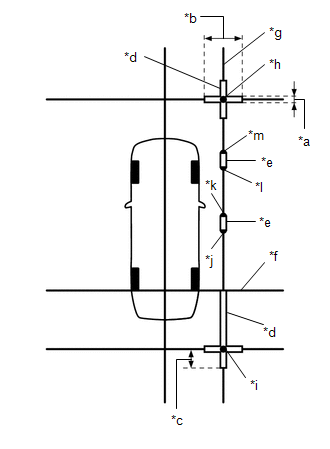
|
*a |
100 mm (0.33 ft.) |
|
*b |
800 mm (2.62 ft.) |
|
*c |
400 mm (1.31 ft.) |
|
*d |
Cross Check Marker |
|
*e |
Check Marker |
|
*f |
String 1 |
|
*g |
String 6 |
|
*h |
Mark I |
|
*i |
Mark N |
|
*j |
Mark S |
|
*k |
Mark T |
|
*l |
Mark U |
|
*m |
Mark V |
NOTICE:
- Place the cross check markers perpendicular to the string.
- Make each arm of the cross check markers 800 mm (2.62 ft.) long and 100 mm (0.33 ft.) wide.
- Extend the rear cross target bars to string (1) as shown in the illustration.
(13) Place the check markers between marks S and T, and marks U and V.
(14) Perform the screen adjustment procedure (procedure 8).
PROCEDURE 7: SET MARKERS (ADJUSTMENT OF ALL CAMERAS)
(a) At the right and left sides of the vehicle, extend strings (5) and (6) parallel to the vehicle center line [string (2)], and place markers.

|
*a |
1300 mm (4.26 ft.) |
|
*b |
except Off Road Package: 4800 mm (15.74 ft.) for Off Road Package: 4700 mm (15.42 ft.) |
|
*c |
Datum Point |
|
*d |
String 1 |
|
*e |
String 2 |
|
*f |
Mark E |
|
*g |
Mark J |
(1) except Off Road Package:
- Mark a position on string (2) in front of the vehicle, 4800 mm (15.74 ft.) from the datum point. (Mark E)
(2) for Off Road Package:
- Mark a position on string (2) in front of the vehicle, 4700 mm (15.42 ft.) from the datum point. (Mark E)
(3) Mark a position on string (2) to the rear of the vehicle, 1300 mm (4.26 ft.) from the datum point. (Mark J)

|
*a |
400 mm (1.31 ft.) |
|
*b |
String 2 |
|
*c |
Mark E |
(4) Fix the ends of 2 strings (800 mm [2.62 ft.] long) at 2 positions 400 mm (1.31 ft.) from mark E as shown in the illustration.
(5) Move the free ends of the 2 strings and mark the point where the ends meet. (Marks F and G)

|
*a |
800 mm (2.62 ft.) String |
*b |
String 2 |
|
*c |
Mark E |
*d |
Mark F |
|
*e |
Mark G |
- |
- |

|
*a |
400 mm (1.31 ft.) |
|
*b |
String 1 |
|
*c |
String 2 |
|
*d |
Mark J |
(6) Fix the ends of two 800 mm (2.62 ft.) strings at two positions 400 mm (1.31 ft.) from mark J as shown in the illustration.
(7) Move the free ends of the 2 strings and mark the point where the ends meet. (Marks K and L)

|
*a |
800 mm (2.62 ft.) String |
*b |
String 1 |
|
*c |
String 2 |
*d |
Mark J |
|
*e |
Mark K |
*f |
Mark L |
(8) Secure strings (3) and (4) to pass through marks F and G and marks K and L, respectively as shown in the illustration.
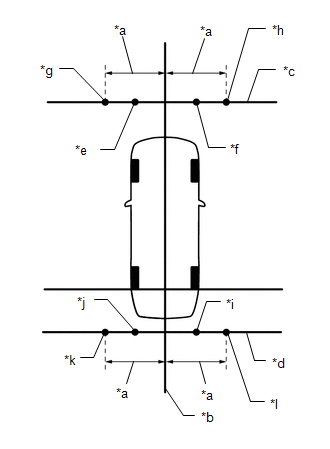
|
*a |
1500 mm (4.92 ft.) |
|
*b |
String 2 |
|
*c |
String 3 |
|
*d |
String 4 |
|
*e |
Mark F |
|
*f |
Mark G |
|
*g |
Mark H |
|
*h |
Mark I |
|
*i |
Mark K |
|
*j |
Mark L |
|
*k |
Mark M |
|
*l |
Mark N |
NOTICE:
When securing the string, check that there is no slack and the string is not twisted.
(9) Make a mark on string (3), 1500 mm (4.92 ft.) to the left and right of the vehicle center line [string (2)]. (Marks H and I)
(10) Make a mark on string (4), 1500 mm (4.92 ft.) to the left and right of the vehicle center line [string (2)]. (Marks M and N)
(11) Secure strings (5) and (6) to pass through marks H and M and marks I and N, respectively as shown in the illustration.
NOTICE:
When securing the string, check that there is no slack and the string is not twisted.
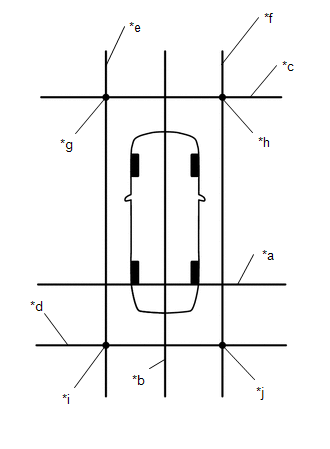
|
*a |
String 1 |
|
*b |
String 2 |
|
*c |
String 3 |
|
*d |
String 4 |
|
*e |
String 5 |
|
*f |
String 6 |
|
*g |
Mark H |
|
*h |
Mark I |
|
*i |
Mark M |
|
*j |
Mark N |
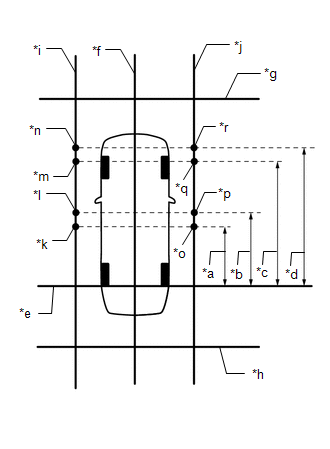
|
*a |
1400 mm (4.59 ft.) |
|
*b |
1600 mm (5.25 ft.) |
|
*c |
3000 mm (9.84 ft.) |
|
*d |
3200 mm (10.5 ft.) |
|
*e |
String 1 |
|
*f |
String 2 |
|
*g |
String 3 |
|
*h |
String 4 |
|
*i |
String 5 |
|
*j |
String 6 |
|
*k |
Mark O |
|
*l |
Mark P |
|
*m |
Mark Q |
|
*n |
Mark R |
|
*o |
Mark S |
|
*p |
Mark T |
|
*q |
Mark U |
|
*r |
Mark V |
(12) Make marks on string 5 that are 1400 mm (4.59 ft.), 1600 mm (5.25 ft.), 3000 mm (9.84 ft.), and 3200 mm (10.5 ft.) from the datum line (string 1) as shown in the illustration. (Marks O, P, Q and R)
(13) Make marks on string 6 that are 1400 mm (4.59 ft.), 1600 mm (5.25 ft.), 3000 mm (9.84 ft.), and 3200 mm (10.5 ft.) from the datum line (string 1) as shown in the illustration. (Marks S, T, U and V)
(14) Place and secure the cross target bars centered on marks H and I and marks M and N as shown in the illustration.
NOTICE:
- Place the cross check markers perpendicular to the string.
- Make each arm of the cross check markers 800 mm long and 100 mm wide.
- Extend the rear cross target bars to string (1) as shown in the illustration.
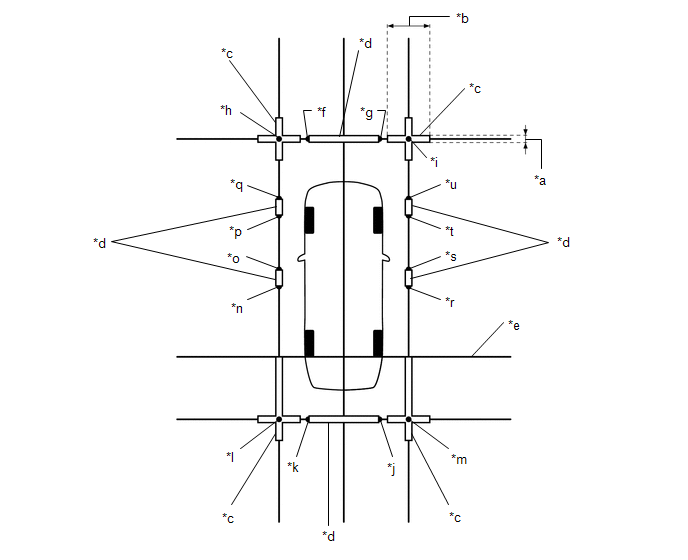
|
*a |
100 mm (0.33 ft.) |
*b |
800 mm (2.62 ft.) |
|
*c |
Cross Check Marker |
*d |
Check Marker |
|
*e |
String 1 |
*f |
Mark F |
|
*g |
Mark G |
*h |
Mark H |
|
*i |
Mark I |
*j |
Mark K |
|
*k |
Mark L |
*l |
Mark M |
|
*m |
Mark N |
*n |
Mark O |
|
*o |
Mark P |
*p |
Mark Q |
|
*q |
Mark R |
*r |
Mark S |
|
*s |
Mark T |
*t |
Mark U |
|
*u |
Mark V |
- |
- |
(15) Place target bars between marks F and G, marks K and L, marks O and P, marks Q and R, marks S and T, and marks U and V.
(16) Perform the screen adjustment procedure (procedure 8).
PROCEDURE 8: ADJUST SCREEN
(a) Enter diagnostic mode.
CAUTION:
Adjustment must be performed with the engine running. Therefore, apply the parking brake, depress the brake pedal and move the shift lever to P to ensure that the vehicle does not begin moving unexpectedly.
(b) Select "Function Check/Setting" from the Service Menu screen.
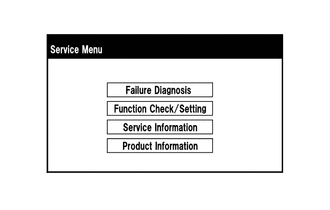
(c) Select "Camera Setting" from the Function Check/Setting I screen to display the Mode Setting(*) screen.
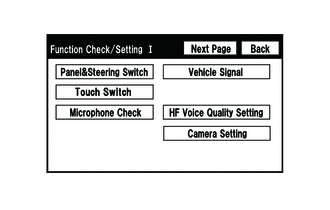
NOTICE:
If "Camera Setting" is not displayed on the screen, turn the engine switch off, and then turn it on (IG) again and enter the diagnostic mode.
(d) Select "View Adjustment" on the Mode Setting(*) screen to display the Signal Check(*) screen.
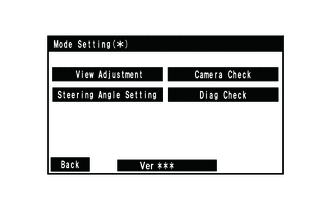
HINT:
To select a grayed out item, select and hold the item for 2 seconds or more.
(e) Select "Next" from the Signal Check(*) screen to display the adjustment screen.
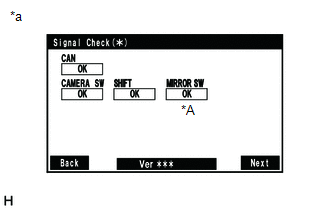
|
*A |
w/ Retract Mirror |
|
*a |
Example |
NOTICE:
- When "CHK" (red) is displayed for an item on the Signal Check(*) screen, selecting "Next" will not change to the adjustment screen.
- Check the Signal Check(*) screen when "CHK" (red) is displayed for an item on the Signal Check(*) screen.
(f) Perform screen adjustment.
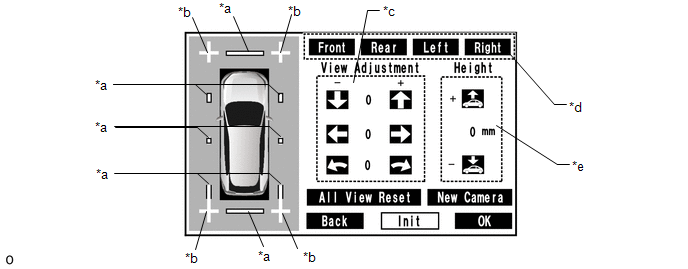
|
*a |
Red Line |
*b |
Cross Check Marker (for Connection Judgment) |
|
*c |
Adjustment Buttons |
*d |
Camera Select Buttons |
|
*e |
Vehicle Height Adjustment Buttons |
- |
- |
NOTICE:
After replacing a camera, use the camera select buttons to select the replaced camera, and select "New Camera".
(1) Check that the cross target bars displayed on the adjustment screen appear connected.

NOTICE:
- Before checking the markers on the adjustment screen, ensure that the cross target bars have been placed correctly.
-
If a cross target bar appears displaced on the adjustment screen, use the camera select buttons to select the corresponding camera, and use the adjustment buttons or vehicle height adjustment buttons to adjust the screen.
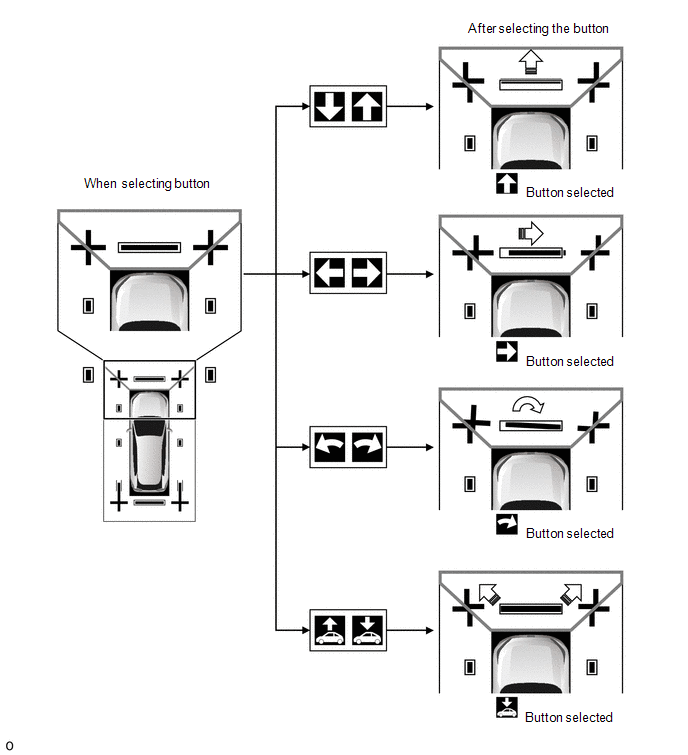
HINT:
To repeat the adjustment, select "All View Reset" to return all adjustment values to their initial values.
(2) Check that the target bars do not protrude outside the red frames displayed on the adjustment screen.
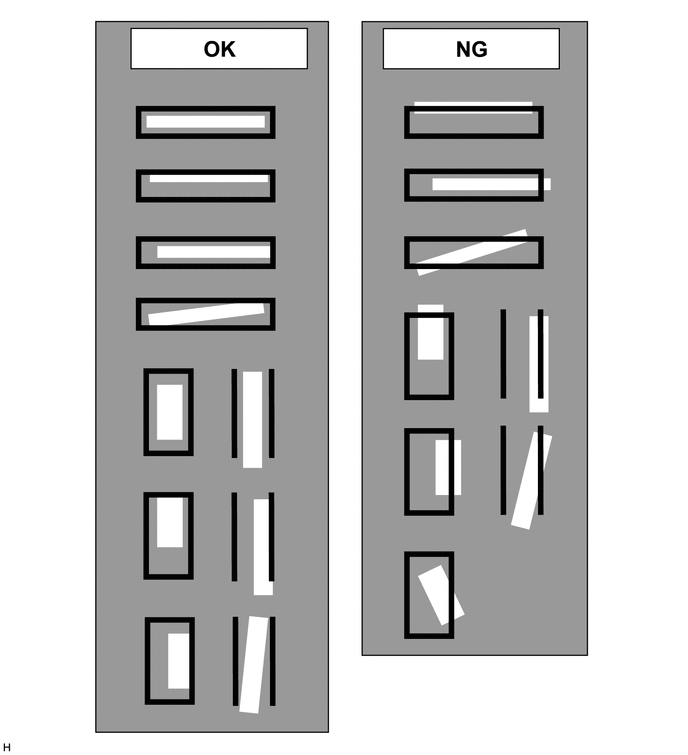
NOTICE:
- Before checking the adjustment screen, ensure that the check markers have been placed correctly.
-
If a target bar protrudes outside a red frame on the adjustment screen, use the camera select buttons to select the corresponding camera, and use the adjustment buttons or vehicle height adjustment buttons to adjust the screen.

HINT:
To repeat the adjustment, select "All View Reset" to return all adjustment values to their initial values.
(g) When all adjustments are completed, press "OK".
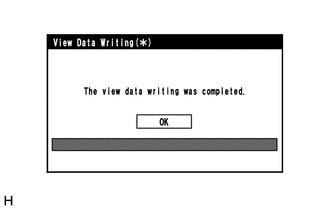
(h) If data writing ends normally, "The view data writing was completed." is displayed.
(i) Select "OK".
(j) Cancel diagnostic mode.
PROCEDURE 9: STEERING ANGLE SETTING
(a) Prepare for adjustment.
(1) Park the vehicle on a flat surface with the steering wheel centered.
HINT:
Before stopping the vehicle, move the vehicle slightly backward and forward to ensure that both the steering wheel and the tires point straight ahead.
(2) Adjust the tire pressure to the specified value(s).
(b) Enter diagnostic mode.
CAUTION:
Adjustment must be performed with the engine running. Therefore, apply the parking brake, depress the brake pedal and move the shift lever to P to ensure that the vehicle does not begin moving unexpectedly.
(c) Select "Function Check/Setting" from the Service Menu screen.

(d) Select "Camera Setting" from the Function Check/Setting I screen to display the Mode Setting(*) screen.
NOTICE:
If "Camera Setting" is not displayed on the screen, turn the engine switch off, and then turn it on (IG) again and enter the diagnostic mode.

(e) Select "Steering Angle Setting" from the Mode Setting(*) screen to display the Signal Check(*) screen.
HINT:
To select a grayed out item, select and hold the item for 2 seconds or more.

(f) Select "Next" from the Signal Check(*) screen to display the Steering Angle Setting D (*) screen.
NOTICE:

|
*A |
w/ Retract Mirror |
|
*a |
Example |
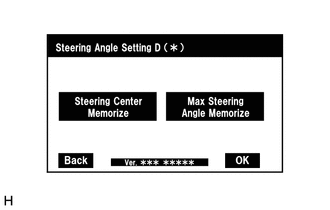
(g) Adjust steering angle.
(1) Check that the steering wheel is centered (approximately +/- 5 degrees or less) and then select "Steering Center Memorize".
(2) After selecting "Steering Center Memorize", turn the steering angle fully to the left and fully to the right, and then select "Max Steering Angle Memorize". (Turning right and then left is OK)
(3) When "Max Steering Angle Memorize" is selected, the steering angle setting values (steering neutral point and maximum steering angle) are stored and the system beeps for a long duration to notify the user that storing is complete before the Mode Setting(*) screen is displayed again.
HINT:
- A long beep will sound to confirm that the adjustment values have been stored.
- When all signals are input normally, the Mode Setting(*) screen is displayed automatically after the maximum steering angle is stored.
- When Steering Angle Setting is incomplete, "OK" is disabled.
- Even if no DTC is output, a steering angle sensor malfunction may disable the use of "Max Steering Angle Memorize".
- If selecting "Max Steering Angle Memorize" does not cause the adjustment value to be stored after adjusting the steering angle, replace the steering angle sensor.
(h) Cancel diagnostic mode.
(i) Confirm steering angle adjustment.
HINT:
After performing Steering Angle Setting, cancel diagnostic mode and perform Steering Angle Setting Check on the rear view screen.
(j) Check on the rear view screen that the displayed estimated course lines move in synchronization with the steering wheel movements when the steering wheel is turned fully left or right.
HINT:
If the estimated course line stops moving before the steering wheel is fully turned to either the left or right, the steering angle adjustment values have not been stored correctly. In this case, perform adjustment again.
|
|
|
![2019 - 2022 MY RAV4 [11/2018 - 10/2022]; PARK ASSIST / MONITORING: PANORAMIC VIEW MONITOR SYSTEM (for Gasoline Model): INITIALIZATION](/t3Portal/stylegraphics/info.gif)